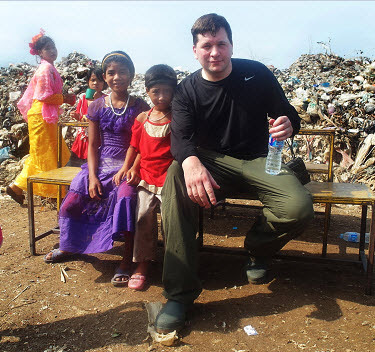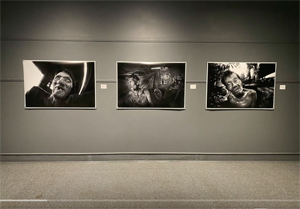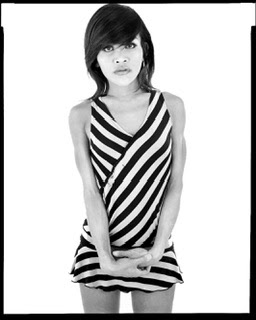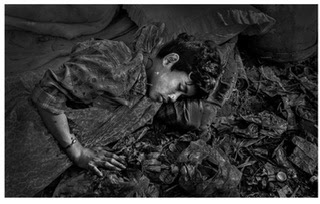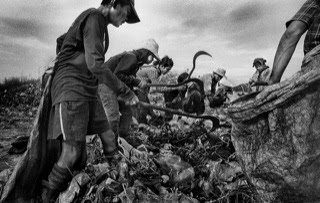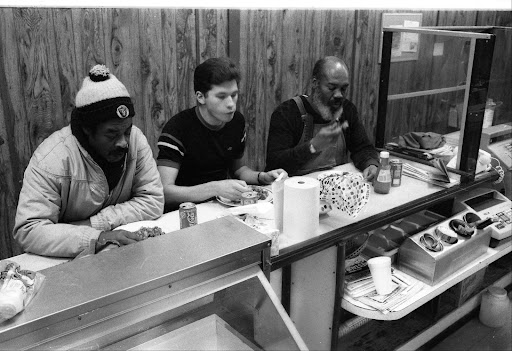Interview: Gerry Yaum - “Families of the Dump”
This Interview by Michael Behlen was originally published in Edition 3 of Analog Forever Magazine, Winter 2020.
“What the fuck am I doing here?” Gerry Yaum asked himself as he followed a young child into the Mae Sot Thailand garbage dump for the first time. Traversing through this area, flies buzzed at him from every angle, covering his body as sweat rolled down his forehead into his eyes that were already squinted from the aggressive bright reflection of thousands of white plastic bags lined this inhospitable landscape. As the young boy pulled far ahead of him, as he was much faster and nimble walking through the mountainous amount of trash, he was now lagging behind. It was then, in the distance: he saw a man in a white hat that he decided he would navigate to in an attempt to capture his first photograph of the area.
When he arrived and was able to identify the person, Yaum realized that the figure he was after was not even an adult but a small, delicate, 9-year-old girl named Iye-iye who was working diligently through a found purse to make sure there was nothing of value left inside by the previous owner. This little child seemed oblivious to the flies, to the heat, to all the things that were making Yaum, a grown adult man, whine and cry. It was at this moment that he thought to himself, “Other foreign tourists are lying on white-sand beaches or staying in 5-star hotels eating shrimp with oysters, and yet you’re here in the garbage, you’re here in this terrible place covered in flies!”
At the same time, Iye-iye just looked at him and smiled. Yaum thought to himself, “What grace this little girl has; she was like an angel glowing in the sunlight with her backlit white straw hat.” He noticed that nothing seemed to bother her, that she was much tougher than most of the grown men we know ourselves. At just nine or ten years old, Iye-iye had found a sense of peace and happiness that most westerners fail to achieve even after decades of practice. This realization gave his soul a well-needed shake-up, and he snapped out of his momentary self-pity of being uncomfortable in this place she called her home.
This experience in 2013 was documentary photographer Gerry Yaum’s first experience in the Mae Sot Thailand garbage dump. This wasn’t his first trip to Thailand and definitely not his first time capturing emotionally challenging documentary work. He has been traveling to Thailand to complete self-funded documentarian work about the economic and social realities of the area since 1996. He previously completed a series on the bar/sex trade called “The Body Sellers” that eventually led him to feel “burnt out by all the negatives, the ugliness, the exploitation, and the waste.” This led him to move on to attempt to photograph something “less emotionally difficult.”
This decision is what fueled his desire to come back to the dump after his first initial visit. He soon discovered that more than 50 Mon and Karen refugee and immigrant families resided there, living in makeshift shacks of found material. Displaced by poverty, war, and political instability of Burma (Myanmar), these families escaped harsh conditions to live in similarly harsh conditions but with one crucial change: the ability to help themselves by scavenging and selling recyclable goods to earn a living. This wasn’t Yaum’s first reaction, as his first thoughts about this place were one of “living hell.” However, over the course of nine years and hundreds of trips, his vision of this place began to change dramatically. The people he met became an inspiration–from the Burmese father who was the first to work each morning and the last to leave the children creating makeshift bobsled garage runs for fun–these people were not those you needed to feel sorry for, but people whose inspiring story needed telling. After reading, make sure to connect with Gerry Yaum on his website!
Yaum doesn’t only tell their story but has become a part of it. What began as a documentary project has turned into a humanitarian one as well. He acknowledges that “I am not changing the world,” but he doesn’t let the scale of his work define him. Since the early stages of his series, now known as “Families of the Dump,” he has simply done what he can. From giving a child a set of rubber boots so they do not have to walk in the garbage barefoot to providing a headlamp to a father so he can work long into the night. He knows that it’s the little things that can make a huge impact on someone’s quality of life. These relationships, built on humble actions, have allowed him to capture the people through a lens of honest dignity instead of through the eyes of an outsider, exploiting impoverished people for the sake of a photographic “project.” As he shared with us, “You capture humanity by treating people in a humane way, respect and kindness goes a long way.”
Ultimately, Gerry Yaum’s series “Families of the Dump” has become less of a documentary project and more of a life project for him. It has taught him, and ultimately us, about the importance of perseverance and hard work. Not only that, but especially how a shanty town of refugee families from several ethnic groups and religions can get along and cooperate for the good of their community. If they can do it, I am convinced that we can too.
I am thrilled to share this interview with Gerry Yaum with you, as it dives deeper into his history and his series “Families of the Dump” than any narration can. We hope that in addition to learning about him as a photographer, you can learn that even you can make a slight difference in the world.
INTERVIEW
Michael Behlen: When did you take up creative pursuits, and what made you stick with it?
Gerry Yaum: The first time I shot a 35mm camera and was in a darkroom was during shop class in junior high school, I was 14 years old. It was the joy of photography, the love of creating images. Making photographs, for me, provides the highest of natural highs. There is so much to love about photography. The best part is the people you meet along the way and the experiences and memories you share with them.
Part of my motivation to create photos and stick with photography relates back to a job I had when I was younger. When I was seventeen, I worked in a veteran’s hospital as a dietary aid giving the residents food and helping them to eat. Many of these veterans had suffered strokes that paralyzed one side of their body. They often had urine bags attached to the side of their wheelchairs. The men pulled and pushed themselves up and down the center’s dark hallways with only one leg and one arm while the bag of urine rattled alongside. In them, I saw my own future. I made a deal with myself: someday, that would be me in that wheelchair, and before I had to live that brutal reality, I wanted to experience a life of adventure and creativity. Photography has given me that opportunity; it has filled me with positive memories so that I can live happily in my old age.
MB: Did you always want to be an artist (are you one?)
GY: The artist thing I always find a bit arrogant and pretentious. I think of what I do in a simpler way. I love to tell stories. I tell the stories of people who might otherwise be pushed aside and forgotten about. I try to make photos that are a tribute, a remembrance of the people photographed. The photographs are only about my subjects and for my subjects. That is how I have always looked at it; it is never about “me” or “my art.” In fact, the name YAUM is actually a pseudonym. It means “Security Guard” in Thai; my real name does not matter. My regular job is that of a nighttime security guard, and I have been doing that for the last 25 years, so YAUM fits the photo work.
MB: When did you begin pursuing documentary photography?
GY: Early on it was a hobby that I was just playing around with but by the time I was seventeen I knew I would be making serious photographs for the rest of my life. I tried to enter a hometown college photography program but was rejected two years in a row. So at 21, I decided to do it on my own, to travel and make pictures of what I found. I borrowed my parent’s motorhome, gathered up all my savings, and went to the United States for 6 months. That was the start of my social documentary photography work. I photographed African American friends in a ghetto in Oakland California in 1985. In 1991, I did another 6-month American trip and made pictures of the gay scene in Los Angeles. The next long trip was to Bangkok to photograph the night scene for 3 months in 1996. Ever since then, I have been returning to Asia almost yearly. These trips eventually led to my series “Families of the Dump.”
MB: What inspired you to travel to Southeast Asia?
GY: I originally went to Thailand to photograph the sex worker life and street life. In Canada, I watched a documentary on the bar girls of Thailand, and it really struck me. There was so much heartbreak in the film; it was very moving. I wanted to understand more, and I wanted to tell the story of those female workers in photographs. So in 1996 I made my first trip to Thailand and entered the bar world. In the coming years, I traveled to Thailand over 20 times. During the first trips, I tried to learn as much as I could about Thai culture, history, and religion. I studied the language, learned to speak some Thai, and also learned basic reading and writing. The sex worker story evolved past photographing female subjects to also include male and transgender workers. The final photo series was called “The Body Sellers.”
MB: What made you step foot into the Mae Sot Garbage Dump?
GY: After many trips and many years of photographing the bar scene, I could not be there anymore. I felt burnt out by all the negatives, the ugliness, the exploitation, and the waste. I decided to move on to photograph something that was less emotionally difficult. I went on to do photo series of other Thai subjects, including Muay Thai boxers and life in the Klong Toey slums. It was in 2013 that I started work in the dump with the families.
MB: How did your expectations and vision of the country change after you first experienced this place?
GY: As to the country, not much changed, by the time I entered the dump in Mae Sot, I had quite a bit of experience and love for the Thai nation. I love its people, culture, and history. My feelings about the dump have changed over time. At first, I thought of it as a living hell. As I grew to know the families over many years, I began to understand the good in the dump. I saw people who came in from Burma (Myanmar) with nothing and, through sheer determination and hard work, built a life for themselves, scavenging (picking) in the garbage. I have photographed many families over many years and watched the children grow up, and saw how things changed for them. The families had survived, and some had even prospered as a result of the garbage dump. So now I see things differently than I did in 2013. Now I see the garbage dump as a necessary evil, as a sort of provider, as a way for a family to make a living and to even prosper. Some of the families literally dig their way to a better, more hopeful future in the garbage dump.
MB: When did you discover the history of the people living there?
GY: After the first trips to Mae Sot and the dump, I learned that most of the people were from the Mon and Karen ethnic groups. I studied the history of the various Burmese ethnic groups, including their geographic locations and the reasons behind the poverty, war, and political instability of Burma (Myanmar). The more I learned, the more I wanted to learn, and the more I wanted to make new photographs. Learning some Burmese language along the way also helped the process. The more you know about your subjects and their lives, the more involved you get, and the better the photographs. Knowing more also builds friendships and access to the lives of the people you photograph. Rich foreign people come to the dump all the time; many do a hit and run, they take what they want, then leave, never returning. I did not want to be one of those types. I try to fit in as best I can and be a part of the family. I wanted to help. On my first trip to the dump in 2013, before I met anyone, I took 3 bags of food to hand out. The most important thing to remember is that you must treat people with the utmost respect and kindness. Learning about your subject’s politics, geography, history, culture, religion, and language is part of that process.
MB: Before your visit to the dump, were you interested in any humanitarian issues or movements? How did this experience change (if at all) your vision of the world?
GY: Yes, I was, I have been doing social documentary-style photographs since I was 21 years old. If anything, my experiences in the dump have made me more hopeful about the world. The families live in extreme poverty but can still smile, laugh, and enjoy life. The dump has taught me to think beyond myself, to find joy in the smallest of things. Here is a quick story to illustrate that: One blistering hot midday in 2016, I was sweating heavily as I walked through the garbage dump loaded down with donations for the families and all my camera gear. It was so hot, damn hot, too damn hot, and the sunlight was blinding! I had sweat dripping off the tip of my nose and rolling down my forehead into my eyes. I struggled to find my way through the waste while trying to prevent my rubber boots from sinking too deep in the mud and filling up with dump waste.
Off in the distance, on a tall hill of garbage, I saw children; they seemed to be playing because I could hear their laughter. I struggled closer and found two small, young boys. The boys have found motorcycle helmets in the garbage that they have put on stunt man-like. They had also found a large gold fiberglass car bumper. As I watched them, they dragged the fiberglass up to the top of the hill, climbed on board together then sledded down the garbage hill using the bumper as a toboggan. All the way down, they screamed with joy. It was their version of Olympic bobsled, a garbage run bobsled. How can you not see the beauty in that? How can you not love to be around those feelings? How can you not want to tell those stories in photographs?
MB: Over your 100 trips to the dump, how have your relationships grown with the families there?
GY: That was a slow process. At first, people would smile shyly and were a bit afraid of me; some would even turn away when I approached. Later as time passed, with continued visits and donation work, most people could see that I was trying to help, so our relationship changed. I knew things were on the right track when some folks started to joke and tease me. The older mothers would scold me for not wearing a hat under the hot sun and tell me I was getting too fat. The children and teens would wave and yell, “GERRY!!!” when they saw me. People started offering food and drinks. I was even hugged one year by one of the fathers after returning to the dump, which is rare in Burmese culture. I also started to get invited to community events. The transition was quite beautiful. It is a great feeling to be accepted. Now in the dump, when new people are wary of me, the old people sometimes jump in and tell them I am okay and not to worry. So the process of getting to know the new people is sped up because of my past history in the dump. Through the years, making pictures in the dump has become easier and easier.
MB: How do you feel one man’s actions can benefit society? Is making a difference in one life enough (I think it is) but just curious about your philosophy behind your commitment.
GY: I try to be a simple and straightforward guy, so my thinking on “making a difference” is simple as well. It basically boils down to “I do what I can do.” I know I am not changing the world, but giving a child a set of rubber boots, so they do not have to walk in the garbage barefoot is a good, positive thing. I know it is the right thing to do, so I try to do it. Doing the right thing is simply the right thing to do, and I don’t try to over-analyze it. I know that if I take 10 CAD dollars, I can go down to the market in Mae Sot, buy a headlamp and then return to the dump and give it to someone. That person’s life just became a little bit easier. Now that person does not have to walk through the dump at night in the dark. Now they can work the garbage more effectively at midnight. I just think of it that way, in those simple terms. I try to help those in front of me, “I do what I can do.”
MB: Have you learned any success stories about a family or person who escaped this situation, with or without your help?
GY: The dump is always in motion, so it is hard to tell. People you have known for years suddenly disappear, and others you have never met are now living in their old homes. I know of families that have prospered financially; many others just seem to get by. Some people have died in their homes in the dump, never making it back to Burma. If there are true success stories, it is with the young people who have the chance to go to school. Some young children learn to speak English, learn of the greater world, and have dreams they want to chase, but it is a slippery slope. One girl who I first met at 10 was married with a child at 14, locked into the life of her parents. Another girl who I photographed for many years was forced to leave school at 15, with no hope of getting to any type of higher education. She spoke to me in fluent English but told me that she could not go further in school because she needed to help her mother and father and that she needed to get a job or work at the garbage dump. So I would say the success stories are there, but they are small ones. If a mother has some education, her children will have even more. I hope that leads to better tomorrow and, at some point, the cycle of poverty is broken.
MB: Your series doesn’t belittle your subjects or turn them into victims. What can the western world learn about themselves from the Families in the Dump?
GY: The families can teach us perseverance, hard work, and the importance of family. Also, the gift of sharing and working together as a community regardless of our differences. The people in the dump are often escaping extreme trauma, rape, war, and poverty. The dump population is made up of people from several ethnic groups within the country of Burma. Often they speak different languages and have different customs and religions. Yet with all those differences, the people still get along, cooperate, work together, and share with each other.
You capture humanity by treating people in a humane way. Respect and kindness go a long way. Photographs are always subjective. I just try to photograph my view of the truth. I try to tell stories with honesty and without exploitation. My goal is to give each person photographed a true voice. I try to interpret them with pictures and tell the story of who they are honest. Photographers know when they are using someone when they are exploiting them. When I feel those negative things are starting to crop up, I stop and move on to something that feels better. It is not that complicated, I learned early on to just follow your heart, it will lead you onto the right path.
MB: Can you share with us a positive experience that surprised you and made your heart warm?
GY: It is 2017, and I have come to Thailand for 6 months. I have taken an apartment in Mae Sot town and rented a motorbike. Every night I drive out to the dump in the darkness, hand out donations and make photographs. During that period of time, the families were mostly working at night. The nights were cooler and easier to work, people would wait for the night garbage trucks to arrive, and then large groups would jump in, scavenging for items of value. In between work periods, they would sit in family groups or with friends, play games, eat, and sleep until the next garbage truck drove in. Usually, I would arrive at the dump around 7 pm carrying my donations. Usually, I had 3 or 4 sets of heavy boots, 10 or so headlamps, over-the-counter medicines, donated toys, 35 mama noodles, and lollipops to give to the children.
This specific night, it was incredibly dark. The only available light came from the garbage trucks that came in and the little headlamps some of the people wore. After I gave out my donations for the night, I was standing in almost complete darkness making and looking for more photographs; I felt something touch my left hand in the darkness. It startled me because I did not realize anything or anyone was near me. I looked down and saw a sweet smile and glowing eyes looking back up at me out of the blackness. It was a small, young girl, maybe 5 years old. She had round white Thanaka circles on her cheeks, a paste made from trees that Burmese people wear. The little girl had just walked up and taken my hand in the darkness while her mother was nearby but working in the garbage. I was not sure what to do, so we just stood for a time holding hands, and then we walked around together for a few minutes in the black night of the dump. Suddenly she let go and ran off, leaving me with a wonderful memory. When I close my eyes, I can still see her face and her sweet smile; it is something I will never forget. I am not a father, and I know very little about raising a child but the feeling of that little soft hand in mine and the trust that girl showed me was simple, moving, and lovely. One of those moments in your life that you remember forever.
MB: Which camera(s) and film did you use on “Families of the Dump”?
GY: I shoot mostly Leica cameras: rangefinder M6s and SLR R6s with wide lenses. My film of choice has always been Tri-x exposed at 200ASA. I shoot Tri-x in all sizes: 35mm, 120, 4x5, 5x7, and 8x10. I develop the 35mm in D-76 2-1 at 20 for usually 12-13 minutes. I like a nice dense negative to work with the enlarger. I use 2 or 3 burning masks to make my final print, then I tone and bleach it. When I want to shoot in lower light I expose the Tri-x 35mm at 800 and then give it STAND development for 1 hour in Rodinal.
With medium-format film, I shoot a variety of cameras: Blads, Rolleiflex’s, and a Mamiya 6. When shooting large format, my current favorites are a Linhof 4x5 and 5x7, and of course, my 8x10 Deardorff. Cameras have always been wonderfully fun objects for me. I have dozens of cameras and just go with the flow. I use the tool that best fits the picture I have in my mind.
MB: As a security guard, how does this career affect your ability to travel to and from this region to complete your work?
GY: Not sure I would call security a career, but it is a good way for me to make money. It has given me the freedom to make my photographs. I can take 7-week vacations once a year to photograph in Asia. In past years, I was able to take extended leaves to travel. In 1999, I spent 10 months in Asia, in 2003, 1 year, and in 2017 and 2018, 6 months. Being a guard who works nights gives me lots of time to think and to plan. I often dream up picture ideas while on shift, while walking my rounds, and long before I go to Thailand. Just don’t tell my bosses. The other guard advantage is that people do not worry or expect too much from you. Security guards are seen as low maintenance, low education, low pay types, so people tend to relax around you. When you tell them you’re only a security guard, they loosen up. When I make photos in Asia, I usually carry a small photo album filled with Canadian snapshots. Me and my parents, me in the mountains, me and my cats, and of course: me in my little blue security outfit. The album helps when I get into situations where I want to introduce myself to strangers or when authority figures like police or border customs people become involved. People get tense and worried
MB: As an American, most security guards would not be able to afford the efforts you are undertaking. How do you accomplish so much?
GY: Affording travel to and living in Asia is not so difficult. The most expensive part for me is the painful 3 plane, 23-hour trip there and back. Once I get in the country, I live as much as a Thai as I can: eating local street foods, renting apartments, and taking buses. I try to stay away from all the tourist places, events, and costs. I speak Thai well enough, so I can interact with the average Thai person and can usually get the lower Thai prices. I do not have children, do not drink, do not smoke, do not do drugs, and do not gamble. I do not have a house or car payments because my house and car are both old. If you want to chase your dreams, you make sacrifices in some areas so you can splurge in others. I also give a lot of credit to my loving mother and father, who taught me so much. My mom and dad were always there for me, reaching out to help when I needed help. My dad is gone now, and my mom is in a home for seniors, but I still look to them for guidance. Without my father and mother’s love, there would be no photographs.
MB: You are currently working on other projects like “The Sex Workers of Thailand” and your series about Canada. How does one person work and achieve so much in their photographic work?
GY: I started at 14, and I am 56 now, so that is 42 years of trying. The trick is to work hard and keep at it. I am not that skilled or talented, but I do work very hard at my photography. My father taught me that. He is the hardest working man I have ever met in my life. He worked a full-time job until he was 79. Second place might be Mr. Win, a Burmese father in the dump who is first to work each morning and the last to leave each night. He is an inspiration. With those hard-working examples in your life, only doing photo things seem rather easy. If you keep working hard and keep at it long enough, then you’re bound to achieve a body of work.
MB: What’s next for you? Do you have any other projects in the works?
GY: In September, I am starting a major photographic project, one that will last the rest of my lifetime. It is called “Ambrotos Kanata”, or “Immortal Canada. It will be the story of Canada in landscapes, cityscapes, and portraits captured nationwide. It will be done in wet plate collodion using a series of ambrotypes using large format and ultra-large format film cameras, including a specially made 35x35 inch view camera from the Czech Republic.










